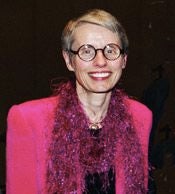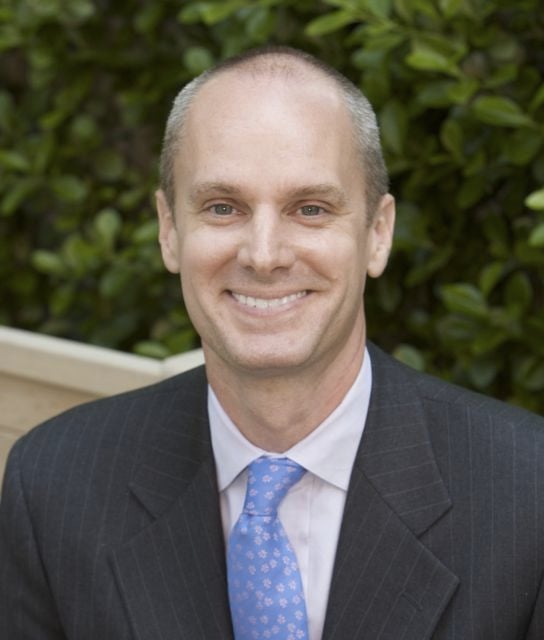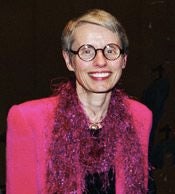Drew Becher succeeds Jane Pepper at PHS tiller
February 23, 2010
By JoAnn Greco
For PlanPhilly
For nearly three decades, Jane Pepper and the Pennsylvania Horticultural Society have been inextricably linked. This year, though, the 64-year-old dynamo retires, and Drew Becher, 40, steps in.

Jane Pepper
He may have big shoes to fill, but Becher seems undaunted. Armed with a varied resume that’s placed him in Chicago, Washington, D.C. and New York City in pivotal greening positions, he is no stranger to Philly. While living in New York — where he has served as executive director of the New York Restoration Project since 2006 — he’s been weekending in a Chestnut Hill home near Morris Arboretum, and he’s closely followed the work of PHS throughout his career. PlanPhilly caught up with him as he prepared to come to town once again to troll the aisles of the Flower Show.
Will anything change at PHS now that you’re taking the reins?
“I don’t think it needs to. Jane’s made it the preeminent urban greening organization in the country, and fortifying that direction is what I’d most like to do. I’d like to get Philadelphia up there so that when the conversation of most sustainable cities in the country arises, it’s not just Seattle and Portland and Chicago that we hear discussed. I’d like to see people come to Philadelphia from all over not just to visit the Flower Show, but to learn from, say, our innovative stormwater drainage techniques.”
What are some of Philly’s biggest challenges from a greening perspective, and how can PHS help?
“Philadelphia needs to stand on a box and be a town crier for awhile, and say ‘Look at me!’. I know that Philly doesn’t like to do that. But, I mean: it has the largest collection of public gardens in the country. It has to figure out how to market this more. There is a market for it.”
How do you plan to up that marketing oomph?
“Well, we’re fortunate that the Flower Show gets such great attention, so it’s really figuring out how to use the Show to showcase the rest of our green urban innovations. Some of that can be done by exploring the technological side of marketing, with multimedia: a better web site, using text messages, taking advantage of guide-by-cell technology, printing pocket guides.”
Let’s talk about some of your earlier successes. You’ve worked in different capacities in three large cities. What’s the defining thread of all of the jobs?
“Landscaping and gardening are some of the biggest bangs for the buck that you can get as far as visual appeal goes. I think a lot of my work has been dedicated to making sure that this stuff is viewed as not just a nicety, but a necessity.”
You seem to have a long personal record of working toward that, too. I read somewhere about how you won a Best Yard competition as a 12-year old, and then when you were in college, you led an effort to improve campus landscaping.
“I’ve always been into greening — maybe it’s because I grew up in Dayton, Ohio. I remember driving past places as a kid and wondering ‘Why don’t they have trees here?’ By the time I got to the University of Cincinnati, I was majoring in urban planning and design, and I decided to do something about it. I worked with the campus facilities department on the notion of developing a master plan. It happened, and it turned out to be one of the most beautiful campuses in the country, with great landscaping components. A lot of campuses now look at it as a model.”
It’s a great story because you took matters into your own hands.
“Yeah, well, I was never one of those people who can sit back and say ‘Someone else is gonna fix that.’ Because you know what?— they aren’t. Even now, I’m continually text mailing while I walk around New York: this is dirty, this needs to be cleaned up. And when most people in Europe are taking pictures of great views or cafes, I’m like, ”Oh my God, look at that bollard! That would really work well back home.’ I notice stuff like that all the time. If you show me a snapshot of a certain street, I can pretty much tell you the city where it was taken.”
As far as the cities in which you’ve worked, what lessons have you come away with?
“In Chicago, a lot is government-driven, so there’s sort of the ‘Life after Mayor Daley’ guessing game. These things may not be a priority for another administration. So adjusting to the power of a particular administration was a big lesson. In D.C., as well, we sort of needed the nonprofit entity piece, the park groups needed some capacity- building. So in the Capital Space Initiative, we made that a priority. In Philly, there are already so many strong park groups, it’s in the genes, and it’s nice. It’s one of the big things I’m fascinated with and appreciate of in Philly: the huge amount of private-public partnerships that PHS has been involved in.”
Specifically, in Chicago, you were around during the run-up to the creation of Millennium Park. What did that project mean for the city?
“We spent a lot of time on the design component, understanding how the spaces would look and feel. The trees weren’t little sticks when they went in, that kind of thing. You immediately had the feel of a place that had been around, that hadn’t sprung up out of nowhere.” Read PlanPhilly’s postcard from Chicago
Well, anything’s possible with investment, hmm?
“Sure, that kind of thing is undoubtedly expensive, but when you look at what’s come out of it, the amount of new buildings and the bump in use and density . . . South of the bridge on Michigan Avenue was never considered a tony area. Millennium Park completely changed that world around State and Randolph streets, new buildings have gone up and it’s a very desirable place to live. It’s all a matter of priorities: great public spaces versus, say, widening the highways.”
What about the other greening efforts the city became so famous for — Michigan Avenue, the green roof at City Hall? Do you think those ideas are transferable to Philadelphia?
“Well, we’ll see. I’ll definitely do my part to advocate for those kind of efforts. This week, I’m going to walk around the Flower Show with the design team and look for ideas. We’ve used this Show for inspiration in Chicago and New York, you know. So, sure, some of that “Wow, spectacular” stuff needs to come out of the Convention Center and onto the streets.”
In each city, you’ve also worked on environmental justice, social accessibility to open space, whatever you want to call it. Here, in Philadelphia, one of PHS’ big projects has been the greening of vacant lots. Is there anything more we can do?
“The clearing of vacant lands has been huge here. Is there still a lot to do? Yeah, and I’m going to have to figure that out. In D.C., we ranked the neighborhoods in terms of open space; and in New York, PlaNYC [the city’s sustainability blueprint] includes open space and playground requirements. I’m not sure if Philadelphia has parameters laid out for certain hot-bed neighborhoods. Instinctively, I know where some of them are — you can just tell when you’re on the train. Re-envisioning those large tracts of land should certainly be a priority.”
In New York, one of the things you’ve been credited with is spearheading the MillionTrees project. Why are trees so important to a city?
“Everyone talks about their beauty and there’s no doubt about that: every place that people love in New York — Riverside Drive, the FDR — has big trees. A lot of them were planted under the Robert Moses years, though, and quite frankly nothing on that scale has happened since then. But they offer more than just beauty, it’s all about stormwater management, the tree canopy acts like a huge green roof. There’s also a public health component, linking trees to reducing asthma rates.”
It’s certainly an ambitious plan. Will it ever be realized?
“Well, you certainly can’t purchase all of the trees at once —in fact, you don’t want to do it all at once. You want to spread out the planting in case there are genetic issues or other problems. But, it’s 10 year strategic plan, and we got off to a flying start by speeding up the pace and going after the low-hanging fruit through reforesting parks, looking at the New York City public housing campuses, that kind of thing. So far, more than 300,000 trees have been planted, exceeding the pace. Moving forward, though, it’ll be tougher to get the numbers. There’s only so much space, for one thing.”
Before you landed there, New York Restoration Project became famous for its fight to keep then-Mayor Giuliani from selling off community gardens owned by the city to private developers. What’s your take on the gardens-versus-development debate?
“I’m pro-development, believe it or not, but a city needs the whole package. You can’t just have buildings, you need a coherent plan that includes enough green space for everyone, in all neighborhoods. If you ask a child to draw a picture of a neighborhood, it’s going to have a house, a school, maybe some shops — and a park. And in a lot of cases, community gardens act as the Central Park for their neighborhood. I mean, it’s not like we’re talking about three gardens on every block. But in Philadelphia, it seems like every neighborhood has one and, in fact, the developers want to be as close to these green spaces as they can get!”
Contact JoAnn Greco, ASJA, SATW, at www.joanngreco.com
Check out her new online magazine, TheCityTraveler at www.thecitytraveler.com
WHYY is your source for fact-based, in-depth journalism and information. As a nonprofit organization, we rely on financial support from readers like you. Please give today.





